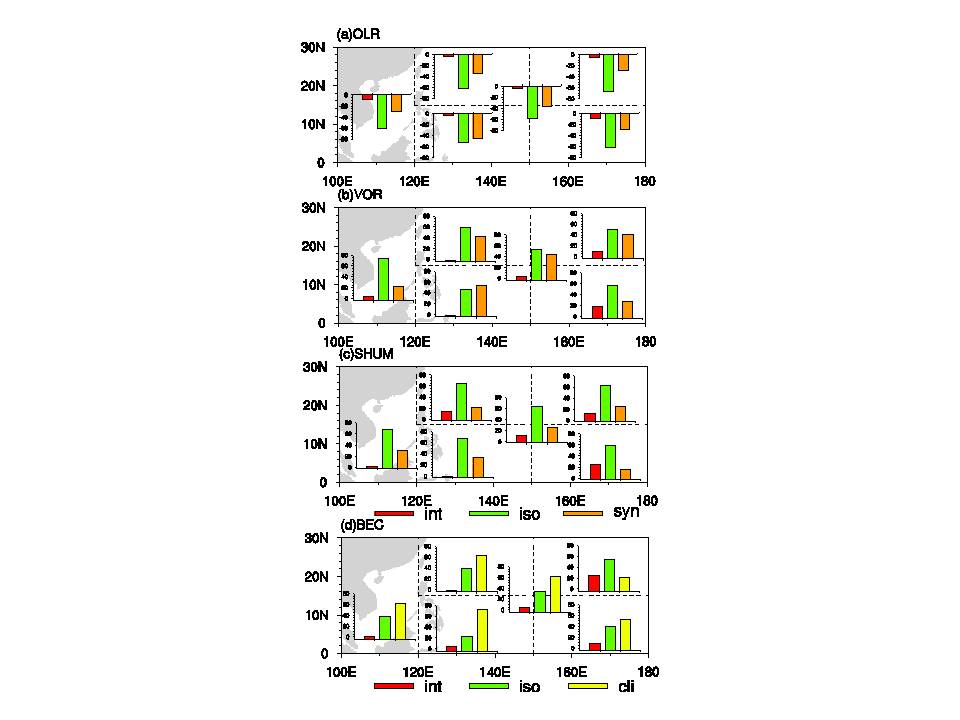State Key Laboratory of Numerical Modeling for Atmospheric Sciences and
Geophysical Fluid Dynamics (LASG)
Institute of Atmospheric Physics, Chinese Academy of Sciences

Vol. 6/No.6 July 2018
[Climate dynamics] A local instantaneous view of tropical cyclogenesis over the western North Pacific
Highlights: The local and instantaneous conditions of the western North Pacific tropical cyclogenesis are mainly determined by intraseasonal and synoptic components of the environmental factors. The differences in local and instantaneous conditions of the western North Pacific tropical cyclogenesis between El Nino developing and decaying years are contributed by the interannual component as well as the intraseasonal and synoptic components.
Summary: Previous studies mostly documented the tropical cyclogenesis based on environmental conditions on a large spatial scale and an average state over a certain period, such as El Niño and La Niña developing and decaying phases and the wet and dry phases of the Madden-Julian Oscillations. However, the tropical cyclogenesis is a local and instantaneous phenomenon. Therefore, a more suitable way is to examine the state at an instant and locality to find out the contributions of various environmental factors to the tropical cyclogenesis.
Recently, Prof. Renguang WU and Drs. Xi CAO and Mingyu BI compared the contributions of different time scale components of various environmental factors to the tropical cyclogenesis over the western North Pacific. It is revealed that the intraseasonal and synoptic components of convection, lower-level vorticity, and mid-level specific humidity have a larger contribution than the interannual component to the tropical cyclogenesis except for specific humidity in the southeast quadrant of the western North Pacific during June through October (Figs. 1a-c). The barotropic energy conversion for the tropical cyclogenesis is mainly from climatological mean winds and the intraseasonal wind component except for the northeast quadrant of the western North Pacific where the barotropic energy conversion from the interannual wind component is comparable to that from climatological mean winds (Fig. 1d). Comparison of contributions of different time scale components between El Niño developing and decaying years indicates that the difference of lower-level vorticity and mid-level specific humidity contribution is mainly due to their interannual component and the difference of convection contribution is largely due to its intraseasonal and synoptic components (Figs. 2a-c). The difference of the barotropic energy conversion is mainly related to the interannual wind component (Fig. 2d).

Figure 1 The percent of tropical cyclogenesis with positive contributions from anomalies of (a) OLR, (b) 850-hPa relative vorticity, (c) 700-hPa specific humidity on interannual (red bar), intraseasonal (green bar), and synoptic (orange bar) time scales and (d) barotropic energy conversion from interannual wind variations (red bar), intraseasonal wind variations (green bar), and climatological mean winds (yellow bar) over the whole domain, northwest, northeast, southwest, southeast quadrants of the western North Pacific, and the South China Sea during June through October.

Figure 2 The percent of tropical cyclogenesis with positive contributions from anomalies of (a) OLR, (b) 850-hPa relative vorticity, (c) 700-hPa specific humidity on interannual (red bar), intraseasonal (green bar), and synoptic (orange bar) time scales and (d) barotropic energy conversion from interannual wind variations (red bar), intraseasonal wind variations (green bar), and climatological mean winds (yellow bar) over the whole western North Pacific during the El Niño developing and decaying June-October (JASO). The percent has been re-scaled by multiplying the ratio of the tropical cyclone numbers in the El Niño developing and decaying JASO over the total tropical cyclone numbers in all the JASO. The difference of percent of four factors between the El Niño developing and decaying JASO is also shown at the right side.
Citation:
Cao, X., R. Wu, and M.-Y. Bi, 2018: Contributions of different time scale variations to tropical cyclone genesis over the western North Pacific during boreal summer. J. Climate, 31(8), 3137-3153, doi:10.1175/JCLI-D-17-0519.1.
Web: https://journals.ametsoc.org/doi/full/10.1175/JCLI-D-17-0519.1
e-mail: renguang@mail.iap.ac.cn
E-mail: lasg_newsletter@lasg.iap.ac.cn
Editors: Chuanyi Wang (wangcy@lasg.iap.ac.cn), Kangjun Chen(ckj@lasg.iap.ac.cn)